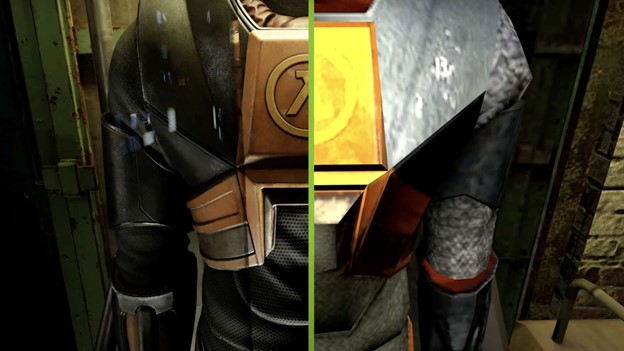Nvidia has just released its RTX Remix tool, which had been available in early access, into open beta. With RTX Remix, game modders can bring a high level of polish to older classic DirectX 8 or 9 games. Using the tools in RTX Remix, users are able to replace older assets and relight scenes, as well as take advantage of path tracing and DLSS 3. RTX Remix is built on Omniverse.
What do we think? There is something to be said about certain classic games that still entice gamers. Give them a 2024 look with today’s technology, and they become even more attractive to players. When Nvidia first introduced RTX Remix last year, it did so by showing off two examples of what can be done with the application. One was a trailer for Half-Life 2 RTX Ravenholm, a community remaster from developer collective Orbifold Studios, the other a reimagining of Portal. Both examples sparked excitement of things to come. And now that the tools are available in open beta, we can expect more RTX mods coming our way.
With RTX Remix, mods never looked so good
While gamers are certainly attracted to the stunning graphics and complex gameplay in today’s cutting-edge titles, there’s something to be said about some games from yesterday. Perhaps it is the nostalgia, or the desire for something that looks and feels a bit different but somehow familiar, or maybe it’s something else. But, what if you can have the best of both worlds—that taste of the past yet with all the latest bells and whistles enabled by cutting-edge technology? With Nvidia’s RTX Remix tool, now available in open beta, modders can transform beloved older games and give them an updated look.
RTX Remix, part of the Nvidia Studio suite, enables modders to more easily revitalize asset materials and relight scenes with path tracing using the power of generative AI, resulting in stunning imagery that is fully ray-traced and takes advantage of the performance boost offered by DLSS 3.
Remix comprises two main components.
The first is custom RTX Remix runtime, which is open source, for scene and asset capture to USD and then for adding remastered assets into the game, in addition to integrating RTX technology into the mod. It also contains something called Bridge, which translates the render from an x86 to an x64 instruction set. Nvidia says that with access to source code, advanced modders can extend the feature set of runtime, enabling them to render fluid sims with realistic volumetrics, add animated lights, replace animated character meshes, and change camera positions, for example.
The other, RTX Remix creator tool kit, is built on Omniverse and used for assigning new assets and lights in remastered scenes, as well as rebuilding and revitalizing the look of assets through the use of AI tools.
With the RTX Remix app, users can easily import game captures. The app’s GenAI texture tools automatically generate physically accurate materials from the original (low-res) textures of the classic title and, according to Nvidia, upscale them by as much as 4×. As users work, they can see their changes live in the RTX Remix viewport. Then, during runtime, RTX Remix swaps out the original assets while infusing DLSS 3, Reflex responsiveness, and other RTX technologies.
Because RTX Remix is built on Omniverse, users can move assets quickly between the app and popular 3D DCC tools via the USD framework. They can also generate new assets in the DCC tool of their choosing and integrate them into the modified game.
RTX Remix results in a mod of a classic game that looks amazing and performs amazingly. Have you ever wondered what Half-Life 2 would look like with today’s technology? Wonder no more. (It looks fantastic.) See for yourself in this Half-Life 2 RTX Remix Ravenholm trailer, which contrasts the clear aesthetic differences with RTX off and on.

With RTX Remix, a person does not have to be a coder or programmer, as the features are manipulated via the tool’s GUI, where users have a wide range of feature choices to choose from, making their mod unique. Nevertheless, Nvidia indicates that users need to be experienced modders to fully experience the application’s capabilities.
Nvidia first introduced RTX Remix at CES 2023, before entering early access. The platform gained attention this past summer with a peek at Orbifold Studios’ Half-Life 2 RTX: An RTX Remix Project and the remastered Portal: Prelude. This week, the tool became available in open beta, opening the door for others to try their hand at modding some older games. (People can download the free RTX Remix open beta here.) However, not every classic game can be turned into a modern masterpiece. According to Nvidia, RTX Remix achieves better results with DirectX 8 and DirectX 9 games that have fixed-function pipelines. A list of compatible games is available here.
According to Nvidia, RTX Remix, as the name indicates, is built to run on RTX-powered machines. Nvidia recommends a GeForce RTX 4070 or higher (or a GeForce RTX 3060 Ti at minimum) The company further recommends these specifications:
- Windows 10/11
- Intel i7 or AMD Ryzen 7 CPU (eight cores; four at minimum)
- 32GB RAM (6GB at minimum)
- 12GB VRAM (8GB at minimum)
- 512GB M.2 SSD (512GB SSD at minimum)
No doubt, we’re going to see a whole new mod, mod world in gaming.